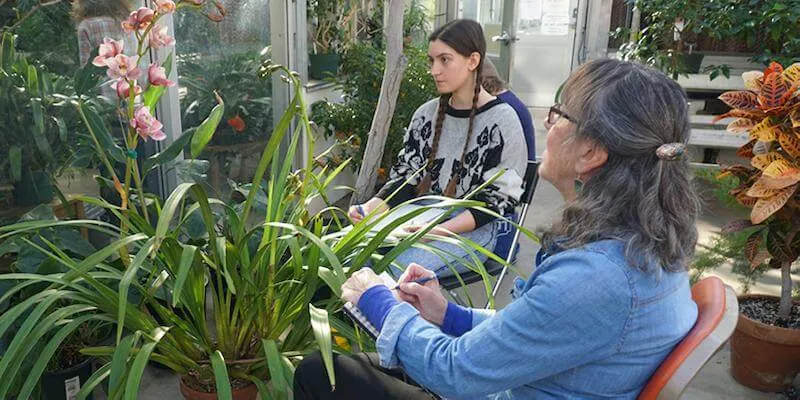Artist Jean Carlson Masseau’s advice to budding scientists: learn to draw. For the past five years, she’s taught a University of Vermont course that aims to do just that.
“The ability to draw helps a person create order out of chaos,” explained Masseau. “We draw because it develops our ability to focus, learn important information about the subject we’re studying, and then record what we see.”
Her course, PSS 096: Drawing and Painting Botanicals, trains students in the skills needed to produce both aesthetically beautiful and scientifically accurate illustrations of plants. Throughout the semester, students gather in the UVM Greenhouse where they use the botanicals surrounding them as their subjects. The course attracts students of all levels and disciplines and meets them where they are – from the novice who has never picked up a sketch pen or paintbrush to the experienced artist. What is particularly remarkable is the artistic and personal growth students experience throughout the semester as they learn to coordinate eye, hand and mind.
Lily Keats ’20 describes herself as being an “art kid” in high school, but lost interest after an AP art class left her feeling defeated and uninspired. A microbiology major, she signed up for the class on a whim seeking to give art another try.
“It was the best class I ever took at UVM,” she said. “I feel like this class helped me in so many ways, both as an artist and a person. Everyone in the beginning doubted themselves, but Jean was so encouraging and compassionate, reminding us to be patient with the process.”
Final watercolor paintings, “Berries and Branches” by Lily Keats and “Orchidaceae” by fellow microbiology major Zoe Kalbag ’20.
Having graduated in May, Keats is confident that her experience in UVM’s Microbiology and Molecular Genetics program prepared her for a range of career paths, from marine biology to infectious disease. The observation skills she gained through Drawing and Painting Botanicals have given her new perspective as a future scientist.
“I don’t think a lot of people immediately see the connection to art and science,” said Keats. “To me, science is beautiful. A plate of cells, a dyed fluorescence scan – that’s art. When I think about the basis of science, it’s observation. It’s about looking at something and seeing its more than what it is; appreciating what’s below the surface.”
Plants offer a lens through which to practice the art of observation, says Masseau. For example, learning to focus on a single flower in a garden setting enables the observer to eliminate the chaos of its surroundings and analyze the subject exactly as it exists in nature. It requires the observer to notice how the leaves are arranged, the patterns of their veins, the number of filaments on the flower, and the spatial relationships between shapes.
“While the camera is a useful tool, our eyes can better isolate a subject from a confusing background and enable us to avoid potential lens distortion through an understanding of the effects of light on color,” said Masseau. “If you’re in the field as a scientist and you have your colored pencils and notebook, you can capture what you see from direct observation.”
Plant biology and studio art double major Braden DeForge ’21 has always been drawn to plants. Through drawing, he’s been able to train his eye to deepen his study of botany, noticing the minute details of a particular plant and gaining insight about its morphology.
“Our world is very visual, and half of it is made up of plants. I’ve always loved being outside, learning the scientific names and families of plants, and becoming more aware. If you really study them, there’s so much more to see,” said DeForge.
Stipple, a process that uses a fine point pen and tiny dots to capture an image, teaches students how to create values and shading. Above stipple drawings by Ethan Harrington ’20 (left) and Zoe Kalbag.
As most students enroll in the course with minimal to no experience, Masseau begins with the basics of learning to relax and draw what one sees. Students first master line drawing with pencils before moving on to shading and using pen and ink. After each assignment, the students come together to learn from each other, observing and critiquing each other’s work.
“The course was full of so much growth because there was so much learning to be had,” said DeForge, despite his extensive experience as an art student. “It felt very communal. The ability to go to the greenhouse with the rest of the class and work together wasn’t something I’d ever experienced before.”
Braden DeForge’s final project, “Ferns and Their Allies,” illustrating ferns and fiddleheads at Salmon Hole in Winooski, VT. His focus on ferns was inspired by his ongoing research in the Barrington Lab.
Coming together through drawing not only built a sense of community among students in the course this spring, but kept them connected when the course transitioned online in March due to the coronavirus outbreak. From weekly help sessions to online discussion boards, Masseau ensured students felt supported while they continued to draw and observe botanicals in their home and natural environments.
“This class was a breath of fresh air when I felt like I was in the middle of a smoky room,” said Keats.
Drawing and Painting Botanicals has been offered at UVM for over a decade, first proposed by plant and soil science lecturer Jane Neroni in 2008 who taught until her retirement in 2017.
